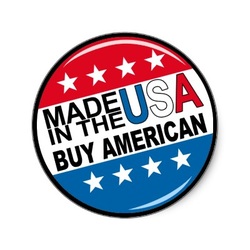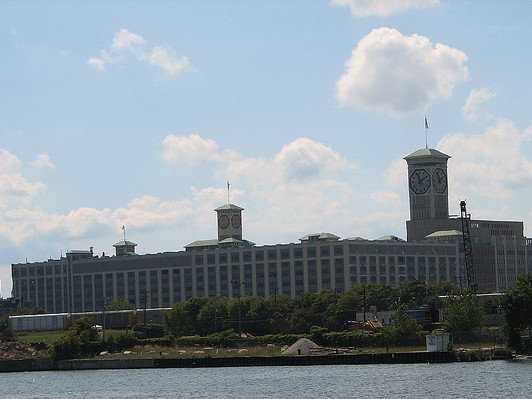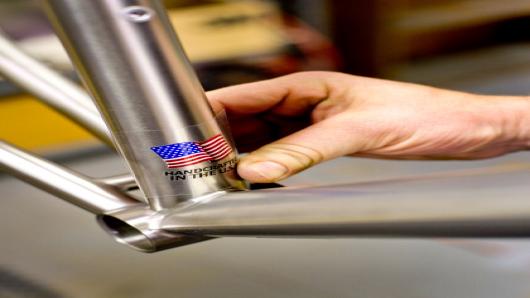Last week, Walmart expanded on the $50 billion Buy American pledge it made last January with a full-fledged Made-in-America summit.
Rockwell Automation sold over $6 billion worth of industrial control products last year, more than half of those outside the United States and over one-fifth to emerging markets. Some 61 percent of its 22,000 employees are based outside the U.S. While 58 percent of last year’s sales were in manufactured devices, 42 percent were in computer hardware, software and communications components.
Take a close look at Rockwell Automation, and you’ll understand why the modern manufacturing industry manages to be both a tremendous economic driver and a tough business in which to get a job. It’s becoming standard for many manufacturing companies to require employees to have college degrees–and some jobs require a PhD. Factory-floor openings are scarce and often require specific credentials. A company like Rockwell Automation creates wealth and jobs all over the world, which is great for the world–and for shareholders– but not always so great for Milwaukee. The city’s number one economic problem is a lack of middle-income jobs, and no industry has yet emerged to replace the jobs the traditional manufacturing sector used to provide.
Rockwell Automation still has a production facility in the Milwaukee area, at an industrial park in a suburb called Mequon. Here, machines print circuit boards embedded with microprocessors containing software coded by Rockwell developers. The circuit boards are then fitted into variable-speed drives, electric motors built to carry specific loads as efficiently as possible. Workers assembling the drives are as likely to spend their shifts peering at data on a computer screen as they are wielding drills.
While the shop floor employs 350 people, the facility also houses 750 workers whose jobs range from marketing to procurement to engineering. The presence of higher-level expertise makes this facility a hub for service and repair work. “We love it because when we have a problem on the shop floor, I can grab an engineer by the ear,” says Thomas Groose, manufacturing engineering manager. Most of the folks working on the shop floor hail from the suburbs. “We’re not on a bus line here,” Groose notes.
Manufacturing remains an important sector in Milwaukee, employing some 14 percent of the metro area workforce. In Wisconsin, manufacturing accounts for about 18 percent of state GDP and 93 percent of exports, according to the National Association of Manufacturers.
But the city and the state have seen a steep decline in manufacturing jobs over the past half-century, and the kind of jobs that remain require a higher level of expertise. Between 1961 and 2001, the city of Milwaukee lost 69 percent of its manufacturing positions. Some of that work relocated to suburbs like Mequon. But overall, the seven counties in southeastern Wisconsin saw a loss of 83,000 jobs, according to Vanderwalle & Associates, a Wisconsin economic strategy firm.
Many jobs disappeared altogether, as high-tech equipment replaced manual labor. The jobs that remain increasingly require applicants to present a two-year degree or a specific certification. Today, fewer than 40 percent of U.S. manufacturing employees have jobs in actual production, according to the Congressional Research Service. The loss of manufacturing jobs had devastating impact on Milwaukee. Like other post-industrial cities, Milwaukee has suffered decades of economic decline and a spike in inner-city unemployment. Today, the city of Milwaukee has the lowest employment rate for working-age African-American males of any city in the country–worse even than Detroit, according to research from Professor Marc Levine at the University of Wisconsin-Milwaukee. The manufacturing jobs that remain are largely suburban and inaccessible by public transportation, putting them out of reach for the population that needs them the most.
Making factories more productive is Rockwell Automation’s business, and executives there find the media focus on job loss frustrating. “We’d like you to start talking about output, and judge manufacturing based on how much stuff we make, not on how many jobs,” says John Bernaden, director of external communications. He points to figures illustrating a 15 percent productivity increase in American manufacturing since 2009 and 16 percent output growth.
Besides, counting manufacturing jobs is misleading, as growth in the sector creates jobs elsewhere, says Michael Laszkiewicz, vice president and general manager of the power control business at Rockwell Automation. “When we make a decision to build a new plant or establish a new product line, and we add new people in manufacturing, for every ten manufacturing jobs we add five or six jobs in the supply chain supporting manufacturing,” he says, including other transportation and service jobs.
“When I look at our economic challenges and the need to reduce unemployment, I think manufacturing needs to get a priority in terms of regulatory and legislative policy so that it’s encouraged to grow,” Laszkiewicz says.
The problem, from the perspective of the average Milwaukeean, is that when a global business like Rockwell Automation builds a new plant, it could just as easily be in Shanghai or Singapore as in Oconomowoc. The supply chain impact need not accrue only in the United States. More often than not, the spillover benefit is spread all over the world, like the company’s business. And support work in service industries often doesn’t pay workers a family-supporting wage.
Rockwell Automation has achieved great success since taking over the Allen-Bradley Company in 1985, but Rockwell and its peers haven’t brought Milwaukee mass prosperity the way that Allen-Bradley and its peers once did. The fourth industrial revolution may be on the horizon, but right now real wages in the area are flat and unemployment remains high.
Rockwell is still hiring, and it’s still taking on entry-level workers. But the company doesn’t hire just anyone. On the shop floor, the company is seeking high-performing students and workers with technical skills. And for its offices, it needs firmware development engineers. “The bar has been raised,” Laszkiewicz says.
“We can’t understand why once the very WTO issues a ruling, the government of the United States does not respect it,” Martinez said.
“We have talked with beef producers in the United States and Canada, and totally agree this is an arbitrary decision and means discrimination against Mexican beef, which we will never agree with and as a government will defend against.”
Meat exporters in Canada and Mexico say the new rules would cut even deeper into cattle and hog shipments that have already slumped by as much as half in the last four years.
The Canadian government has threatened a possible retaliatory strike against U.S. imports, and is hoping Mexico will join it.
The WTO Appellate Body said last year that U.S. country-of-origin labeling rules, commonly known as COOL, were wrong because they gave less favorable treatment to beef and pork imported from Mexico and Canada than to U.S. meat.
Meat labels became mandatory in March 2009 after years of debate. U.S. consumer and some farm groups supported the requirement, saying consumers should have information to distinguish between U.S. and foreign products.
China’s Favorite U.S. States in 2012
In 2012, China purchased nearly $109 billion worth of U.S. goods, from soybeans to scrap metal, electronic components to heavy machinery. China will undoubtedly play a significant role as importer of Made in USA as locals keep getting richer. Some estimates forecast that China may have nearly 600 million middle class consumers by the end of the decade, as measured by the World Bank’s definition of middle class.
“Our exports to China remain a bright spot for many companies, particularly with European demand weakening,” said Frisbie in a statement last week.
Even though China’s economic growth slowed last year, growth in U.S. exports to China rose 6.5% from 2011, representing an increase of $6.6 billion.
Here’s a look at the top 10 states where Chinese companies go shopping for Made in USA.
Just last week, a clothing factory in the country collapsed, with the body count now at over 500. Police have arrested the building’s engineer, who claimed the building was unsafe as-is, but allegedly played a part in adding three more floors to it regardless. The clothing factory itself was a station that produced American goods on the cheap cheap for large business chains such as J.C. Penny, Walmart, and H&M, to name just a few. This recent event has placed a lens of scrutiny under Western retailers for outsourcing cheap labor, but cheap labor overseas has always been an issue. It is American business and consumption that are driving forces behind the dismal conditions of oversea factories. Of course, it’s a reality that most businesses want to keep quiet and it’s something we may have heard in passing but want to ignore—because changing our shopping habits entirely would be a pain.
On the flipside, Bangladesh’s problematic clothing industry makes up for 80% of its exports.
Let’s pause for a moment and talk about China.
Back in February, I wrote a piece on how Chinese New Year celebrations were dampened by the country’s ongoing smog crisis. Since then, smog levels have not gotten any better. They’re hitting nearly decade-level highs in Hong Kong and ruining chances at a healthy upbringing for children growing up in urban cities. Goodness forbid if we were faced with these types of environmental hazards across America — but since it’s China, the average American could probably care less. But why is it that China is so steep in air pollution? Because of all its factories — and what are those factories producing? Cars that Americans drive, clothes that Americans wear, toys that American children play with, computers that Americans type with, the list goes on and on. The kicker is that this production occurs in the same sweatshop, underpaid conditions as Bangladesh, Haiti, the Dominican Republic, and other places.
In light of the Bangladesh factory collapse, Disney is pulling from developing countries all over, but such drastic movement leads to a loss in jobs. What companies can do is flex their financial muscles and influence for an improved quality of work conditions overseas. Then again, that requires time, effort and resources — three elements that American companies probably aren’t aiming for in their desire to get their goods produced quickly, cheaply, and exported for more than a worker’s measly paycheck.
What we can do as consumers in order to shop more ethically is to research and spread the word. It’s our duty as consumers of these products to speak loud for the voices that suffer to provide for us.
About the writer:
Zainab is an undergraduate student born and raised in New York City, studying mass communications and journalism at the University of Delaware graduating in May 2013. Her interests include politics, fashion, writing, the media arts, travel, unhealthy doses of pop culture, intersectionality, and cultural criticism. She has written for university’s school newspaper, The Review, in addition for the Intellectualyst, a progressive online newspaper. Currently, she is a writing intern at PolicyMic. In 2011, Zainab assisted in research with University of Delaware’s Dr. Danilo Yanich which has since then been studied by the Federal Communications Commission and discussed in the New York Times. She is a member of three national leadership and honor societies. Currently her passions lie in the BBC rendition of Sherlock, philosophy, blogging, and books. Blog: In Medias Res
Staff writer
The Walt Disney Co. is pulling out of Bangladesh and several other developing countries, in part because of fatal accidents in factories that produced branded merchandise for Western firms. Announcement of the move follows last week’s collapse of a Bangladesh garment factory building, a tragedy that may be the worst such accident in world history. The official death toll is now more that 500 and keeps climbing as rescue workers continue the slow process of working through building rubble.
|
A Bangladeshi woman looks at a wall filled with portraits of missing persons near the site of a garment factory that collapsed last week in Savar near Dhaka, Bangladesh, Friday. Disney pulls out of Bangladesh and several other developing countries, in part because of fatal accidents in factories that produced branded merchandise for Western firms. | Ashraful Alam Tito/AP
|
Disney officials said their pull-out decision was actually made in March, after a fire in a Bangladesh factory last November that killed more than 100. The company has told licensees that it wants to phase out production of Disney-brand items made in Bangladesh, Pakistan, Belarus, Ecuador, and Venezuela.Disney said it relied on World Bank Governing Indicators, which measure rule of law, corruption, and other national characteristics, to help make its decision.
“After much thought and discussion we felt this was the most responsible way to manage the challenges associated with our supply chain,” said Bob Chapek, president of Disney Consumer Products, according to a CNN report.
Are Western firms such as Disney, the Gap, and Benetton in part responsible for the conditions that lead to these tragedies in low-wage nations? Disney’s move shows that some feel their reputations are at risk, at the least, if they are tied too closely to foreign workplace tragedies.
Customers may avoid brands they suspect of abetting worker abuse. And a number of international nongovernment organizations today stand ready to publicize poor conditions found in factories linked to major nation retail brands.
But these NGOs don’t necessarily want their pressure to result in pull-outs. They want corporations to use their economic muscle to improve conditions.
The Washington-based Workers Rights Consortium, for instance, says it works with big companies and their foreign licenses to try to remedy problems before issuing public reports.
“The WRC views ‘cutting and running’ from a factory as a serious abrogation of a licensee’s responsibilities,” says the group in a statement.
Worker groups often want foreign firms to stay to preserve jobs and economic development. Some experts say the blame for tragedies such as the Bangladesh building collapse should be directed at local and national authorities who have the responsibility to protect their workers.
“By misassigning the responsibility for the recent tragedies to global retailers, western media and consumer movements allow the real culprits to get away scott-free and further diminish the likelihood of governance reform in poor countries,” wrote Jagdish Bhagwati, senior fellow for international economics at the Council on Foreign Relations, and Amrita Narlikar, director of the Centre for Rising Powers at the University of Cambridge, last month in the British magazine Prospect.
Other experts put the problem in a larger political frame. The real problem in Bangladesh has been the complex trade apparatus erected by the US, which consumes most of the cheap clothing produced in developing nations, wrote Mallika Shakya, an assistant professor of sociology at South Asian University in Delhi, in the Indian newspaper The Hindu.
Between 1974 and 2004, the US Multi-Fiber Arrangement virtually dictated, item by item, the amount of clothing that third-world countries could export to the US, according to Ms. Shakya. Potential rivals to America such as China got small quotas, while Bangladesh and other unprepared nations got large ones.
The result was that Bangladeshi authorities could not keep up with the explosive growth of their country’s garment industry.
“That is a reason why most factory buildings are found to be built haphazardly, without acquiring the necessary clearance from state agencies,” wrote Shakya.
That happened in January, when Lenovo, a Beijing-based computer maker, opened a new manufacturing line in Whitsett, N.C., to handle assembly of PCs, tablets, workstations and servers.The rationale? The company is expanding into the U.S. market and needs the flexibility to assemble units for speedy delivery across the country, says Jay Parker, Lenovo’s president for North America.But also — and this was crucial — the math added up. While it’s still cheaper to build things in China, those famously low Chinese wages have risen in recent years. “We reached the point where we could offset a portion of those labor costs by saving on logistics,” Parker says.
U.S. firms that have long operated abroad are making similar moves: Caterpillar, GE and Ford are among those that have announced that they’re shifting some manufacturing operations back to the United States. And economists are debating whether these stories are a blip — or whether they signal the beginning of a major renaissances for American manufacturing.
It’s easy to be skeptical. So far, the effect on jobs has been modest. Since January 2010, the United States has added 520,000 manufacturing jobs — and of those, 50,000 have come from overseas firms moving here, according to the Reshoring Initiative, an industry-led group. (That includes 115 in the new Lenovo plant.) That’s a decent number, but it pales beside the 6 million factory jobs that the Bureau of Labor Statistics says vanished between 2000 and 2009.
Yet the optimists counter that the logic of a coming renaissance is impeccable. Besides the shrinking wage gap between China and the United States, the productivity of the American worker keeps rising. And the surge in shale gas drilling gives the United States a wealth of cheap domestic energy to bolster industries such as petrochemicals.
All that could combine to make U.S. factories more competitive in the years ahead, not just with Europe and Japan, but with the manufacturing behemoth inChina. This shift likely won’t mean the United States will have 19 million manufacturing workers again, the way it did in the 1980s. For one thing, automation is still a powerful force. And the types of jobs that come back will be different from the ones that vanished. Still, any significant uptick in domestic manufacturing after a decades-long decline could bolster the economy and spur innovation.
“I think it’s fair to say this hasn’t all registered in the data just yet,” says Scott Paul, the president of the Alliance for American Manufacturing. “But we’re starting to lay the groundwork where we’ll start to see a real effect three to 10 years from now.”
Laying the groundwork
So what does that groundwork look like? For many analysts, the narrowing of the wage gap between China and the United States is the most significant factor.China has been getting wealthier, and its factory workers are demanding ever-higher wages. Whereas the gap in labor costs between the two countries was about $17 per hour in 2006, that could shrink to as little as $7 per hour by 2015, says Dan North, an economist with Euler Hermes, a credit insurer that works with manufacturers.
“If you’re a U.S. company and the advantage is only $7 per hour, suddenly it may be worth staying home,” North says. “If I stay here, I have lower inventory costs, lower transportation costs. I’m closer to my market, I can have higher-quality production and I can keep my technology.”
This notion appears to be catching on. In February 2012 survey from the Boston Consulting Group (BCG), 37 percent of U.S. manufacturers with sales above $1 billion said they were considering shifting some production from China to the United States. The factors they pointed to were not only that wages and benefits were rising in China, but the country is also enacting stricter labor laws and experiencing more frequent labor disputes and strikes.
“Companies are realizing it’s not as easy to do things in China as they thought,” says Hal Sirkin, a senior partner at Boston Consulting Group who has been predicting the convergence of labor costs since 2011.
The flip side is that American workers are becoming more attractive — for a mix of reasons. Worker productivity has been rising steadily over the years. Also, BCG says, the decline of U.S. organized labor is luring companies home, particularly to the nonunion South. Unions, for their part, have often responded by allowing wages to fall in order to keep jobs in the United States. Ford started bringing back production from China and Mexico after an agreement with the United Auto Workers let the company hire new “second-tier” workers at lower wages.
As a result, Sirkin’s research at BCG suggests that some industries could slowly migrate back from China. That includes industries such as plastic and rubber, machinery, electrical equipment and computers and electronics.
Nor is it just China. BCG also found that the United States is on pace to have lower manufacturing costs than Europe and Japan by 2015. Already, companies in those regions have been moving production here. Nissan, Honda, and Toyota are ramping up their exports from the United States. In 2008, Ikea opened a new furniture factory in Danville, Va., to cut shipping costs. The European aerospace company Airbus has just broken ground for a new factory in Mobile, Ala.
America’s glut of cheap natural gas from shale fracking is also attracting its subset of industries. Factories being built in Texas and Pennsylvania will convert natural gas into ethylene, a key ingredient in plastics and antifreeze. An Egyptian company, Orascom Construction, is building a $1.4 billion fertilizer plant in Iowa near a natural-gas pipeline.
Most of the evidence that “reshoring” is happening is anecdotal, and there’s a limit to how far it is likely to go. For one thing, North says, the industries most reliant on cheap labor — including textiles and mass-produced clothing — will likely never return to the United States. Moreover, China has built up a formidable manufacturing infrastructure that will keep many companies there, even as labor costs shift.
“Chinese suppliers have now developed dense supplier networks that now have their own capabilities for introducing new products,” says Suzanne Berger, a political science professor at the Massachusetts Institute of Technology who studies manufacturing. “And, of course, China is a market that’s growing extremely rapidly — so many companies will want to stay in close proximity to those customers.”
But the early signs are notable. Sirkin points out that his model of labor costs didn’t predict that companies would start coming back to the United States until 2015: “We’ve already seen more movement than we expected.”
Industry has changed
Policymakers’ efforts to bolster domestic manufacturing, however, will have to take into account how dramatically the industry has changed since the 1980s.
In a recent report, an MIT task force described how the U.S. manufacturing landscape is no longer dominated by large firms such as Dupont, IBM and Kodak that could handle every aspect of production themselves. Instead, the future of manufacturing will consist of smaller firms that may not always have enough money to train workers, commercialize new products and procure financing on their own.
“There are these holes in the ecosystem, and we have to think of another way to provide all these capabilities if we want to see manufacturing revived,” says Berger, a co-author of the report.
Some firms have partnered with local universities or governments to develop these capabilities, she says. In Rochester, N.Y., for instance, the demise of Kodak meant that there was no longer a dominant company paying to train new skilled workers. So smaller firms in the optics industry banded together to plan new community college curricula and fill the gap.
In New York, the state government has tried to support semiconductor manufacturing by bringing together private firms, research labs and degree programs to share common facilities, expensive equipment, training and research.
The Obama administration is spending $1 billion to fund similar hubs around the country. The first is the National Additive Manufacturing Innovative Institute in Youngstown, Ohio, which will focus on the development of 3-D printing and other processes for manufacturing objects from digital models.
According to the MIT report, such partnerships have the potential to be far more effective than the old model of handing out tax breaks for manufacturers. That’s because they don’t leave a state or locality at the mercy of a single firm that could leave at any time.
How many jobs will return?
There’s also the key question of how many jobs are likely to come back. The United States has 11.9 million manufacturing employees, and experts tend to agree we’re unlikely to see a return even to the much-diminished levels of the 1990s, when there were more than 17 million factory positions.
President Obama has set a more modest goal of 1 million new manufacturing jobs by the end of his second term. But Paul of the Alliance for American Manufacturing says the country is behind pace to achieve even that “reasonable goal.”
The new manufacturing jobs, meanwhile, will also be different from the jobs of old. For one, many plants are now setting up in the nonunion South, and organized labor has largely been shut out of the manufacturing renaissance. On balance, all of the job gains since 2009 have been nonunion. And, unlike 30 years ago, manufacturing jobs no longer have higher average annual earnings than the typical private-sector worker.
At the same time, technological advances will continue to displace factory jobs in the United States and elsewhere. Germany and China — two manufacturing titans — are slowly losing positions because of automation. A report last fall by the McKinsey Global Institute found that the price of robots relative to the cost of human labor has fallen 40 to 50 percent since 1990, and that trend is expected to continue.
Paul, however, points out that Germany has lost jobs at a much slower pace than the United States over the past decade, which suggests that there’s room for improvement. “There’s nothing inevitable about the sort of steep declines we’ve seen here.”
What’s more, experts point out that there are still plenty of other advantages to bringing manufacturing back home. Manufacturing firms tend to spend more on research and development than other businesses, and recent research has focused on the fact that the act of building things can lead to key innovations. Procter & Gamble and Gillette are two companies known for their run-of-the-mill products — diapers and razors — that have turned innovations in the manufacturing process into a key part of their business.
What’s more, the MIT report says, manufacturing can be a potent driver of other service-industry jobs. A small company in Ohio that makes protective sleeves for pipelines, say, will be in a good position to offer technical support for oil platforms and other companies.
“We have the wrong picture if we think on the one hand there’s manufacturing and on the other hand services,” Berger says. “And the idea that we’re going to just go from one to the other is wrong. Almost all valuable things are some bundle of manufactured goods plus services attached.”
A curious thing is happening among American shoppers. More people are taking a moment to flip over an item or fish for a label and ask, is it “Made in the USA?” Walmart, the nation’s largest retailer, earlier this year announced it will boost sourcing of U.S. products by $50 billion during the next 10 years. General Electric is investing $1 billion through 2014 to revitalize its U.S. appliances business and create more than 1,500 U.S. jobs.
Mom-and-pops are also engineering entire business strategies devoted to locally made goods — everything from toys to housewares. And it’s not simply patriotism and desire for perceived safer products which are altering shopping habits.
The recession, and still flat recovery for many Americans, have created a painful realization. All those cheap goods made in China and elsewhere come at a price — lost U.S. manufacturing jobs. A growing pocket of consumers, in fact, are connecting the economic dots between their shopping carts — brimming with foreign-made stuff — and America’s future.
They’re calculating the trade-offs of paying a little more for locally-made goods.”The Great Recession certainly brought that home, and highlighted the fact that so many jobs have been lost,” said James Cerruti, senior partner for strategy and research at consulting firm Brandlogic. “People have become aware of that.”
‘Made in the USA’ is known for one thing, quality,” said Robert von Goeben, co-founder of California-based Green Toys. All of their products from teething toys to blocks are made domestically and shipped to 75 countries.
“We are reaching a tipping point, where Americans are relearning its competitive advantage,” von Goeben said. “It’s not about the cheapest product, but the best quality product.”
For many consumers, affordability has driven the bulk of purchasing decisions. Businesses in turn have ventured abroad for cheap labor and specific manufacturing skills to keep prices down.
So what’s driving big and small businesses to increase sourcing of U.S. products — beyond the obvious good PR?
In short, a shift in global manufacturing that’s in the early stages. A combination of factors including rising labor costs are eroding China’s cost advantage as an export platform for North America.
Mexico, meanwhile, is rebounding as a manufacturing base, and wages there will be significantly lower than in China, according to a Boston Consulting Group report. By 2015, BCG forecasts that for many goods destined for North American consumers — manufacturing in some parts of the U.S. will be just as economical as manufacturing in China.
For years, the main attraction of China outsourcing has been access to low-cost labor. But pile on related business costs such as transportation of goods, duties and industrial real-estate expenses, and the global manufacturing landscape is no longer China-dependent.
Domestic manufacturing, meanwhile, is on the mend. The pace of growth in the U.S. manufacturing sector picked up to its fastest rate in more than a year and a half in February, as new orders continued to accelerate.
And imported goods — at least in footwear and apparel — are retreating slightly. While more than 97 percent of apparel and 98 percent of shoes sold in the U.S. are made overseas, U.S. imports in those two categories in 2011 declined for the first time ever since such data has been tracked by the American Apparel & Footwear Association.
“The cost competitiveness of U.S. manufacturing is on the rise,” said Cerruti of Brandlogic.
Of course, plenty of goods are still made abroad. And many Americans are broke, jobless or underemployed four years after the 2008 economic crisis. An unemployment measure that factors in those who have quit looking for jobs, as well as those working part-time for economic reasons, is at 14.4 percent. For many, buying “Made in the USA” is a luxury they can’t afford.

Sarah Wagner was inspired by a road trip including tours of US companies to create USA Love List, a website devoted to American-made goods.
USA Love List[p][/p]
Despite many shoppers’ thin wallets, there’s a growing appetite for domestically-made goods.
Blogger Sarah Wagner has turned her passion for “Made in USA” products into a successful website. USA Love List is devoted to sourcing and showcasing where to buy domestically-made items, ranging from lip gloss to pet food. She regularly scans the aisles of big retailers such as Costco and Target for American-made goods.
Site traffic has mushroomed since USA Love List launched in November 2011. “There’s clearly a hunger for this sort of information,” said Wagner, based in Philadelphia. “Companies have no idea how much Americans want to support American companies. They want to get behind their neighbors and communities to make sure those jobs stay there. It’s struck a nerve with a lot of people,” she said.
American-Made Green Products
Among the growing piles of American-made goods, many are green with recycled materials. Turns out it’s easier to manufacture green products domestically because sourcing of recycled materials including recycled plastic is particularly plentiful and transparent in the U.S., said Jenna Sellers Miller, president of Architec Housewares, a 9-employee housewares business, based in Delray Beach, Fl.
Some of Architec’s EcoSmart line of products are sourced domestically. The products are available at Target, Macy’s and Bed Bath & Beyond. “We’re getting appointments with retailers who just want to see our ‘Made in the USA’ products,” Miller said.
Domestically sourced recycled materials and a broader commitment to the environment shape Green Toys business strategy as well. With their factory and warehouse 10 miles apart in northern California, they also cut transportation costs and related emissions.
The 12-employee company also creates a ripple effect of jobs including supporting local drivers, shipping and packaging companies and testing labs. “We could not have started this company anywhere else,” von Goeben said. “This is a uniquely American company.”
Later this year, Green Toys will ship its first batch of toys from northern California to China. Said von Goeben, “It’s the irony of all ironies.”
Walmart announced bold commitments to increase domestic sourcing of the products it sells and help veterans find jobs when they come off active duty. Speaking at the National Retail Federation’s annual BIG Show, Walmart U.S. President and CEO Bill Simon also announced the company is helping part-time associates who want to be full time, make that transition. Read more
INQUIRIES
Media: PR Department
Partnership: Marketing
Information: Customer Service




















